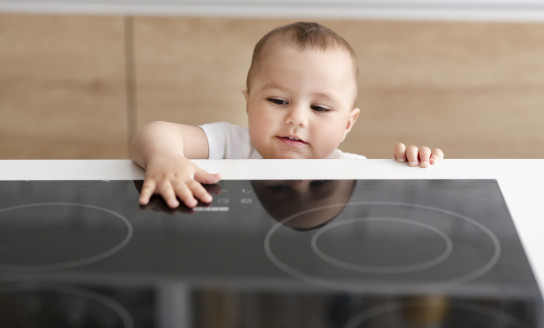There are two main causes of burns among children in New Zealand:
- hot liquids (tea, coffee, soups)
- hot tap water (showers, baths, and sinks).
Prevention
Preventing burns is the best way to keep your kids safe. Below are some tips to minimise the risk of burns in your home:
In the kitchen
- keep hot beverages, or foods, like soups and noodles, out of reach from your child
- avoid holding or feeding your baby when you are drinking tea or coffee
- keep cords of kettles out of your child’s reach
- cook at the back of the stove first
- turn pot handles in, so they are less likely to spill
- if you are cooking and must leave the room for any reason, turn the stove off first.
In the bathroom
- always watch young kids in the bath or shower, or when they wash their hands
- start with cold water then add hotter water to your child’s bath
- if you are using a bath tub, run the cold tap to finish so that the tap fitting isn't hot to touch.
In the bedroom
- avoid candles in the bedroom
- turn electric blankets off before going to bed.
Water temperature
- adjust the hot water temperature in your house (50-55 degrees Celsius is recommended), because a few degrees can make a big difference.
Other areas
- put matches and lighters out of reach of children and in a locked cupboard, if possible
- make sure all electrical outlets are working and safe
- always use a candle holder and put out all candles before leaving them room.
Treatment at home
Mild burns can usually be treated at home, while severe burns require medical attention. If your child has a mild burn, follow the steps below:
- remove the source of heat –get your child away from whatever caused the burn (stove, candle, BBQ)
- immediately cool the burned area for at least 20 minutes
- you can use slow-running cold water, or any cool, clean liquid (a soft drink or beer if you don’t have access to cold water). Do not use ice
- you can also submerge the burned area in a bucket of cold water, if that’s easier than pouring water over the burn
- position your child in a safe position
- apply a sterile dressing that does not have a sticky adhesive, or a clean piece of cling film.
Things to avoid
- Do not break blisters or remove peeled skin
- Do not try to remove any fabric that is stuck to a burn
- Do not apply creams, ointments, lotions or butter to any burn injury because infection may occur and make the injury worse
- Do not place young children or babies in a cold bath or shower for a full 20 minutes, as this can cause hypothermia.
When to visit the doctor
Bring your child to the doctor if they're in a lot of pain, or you are worried about them. If you’re not sure what to do, call PlunketLine.
When to call 111
Immediately ring for an ambulance if:
- your child is badly injured
- the burn is causing significant pain
- the burn involves the eyes, or is larger than half the child’s arm.
Burns: Key facts
